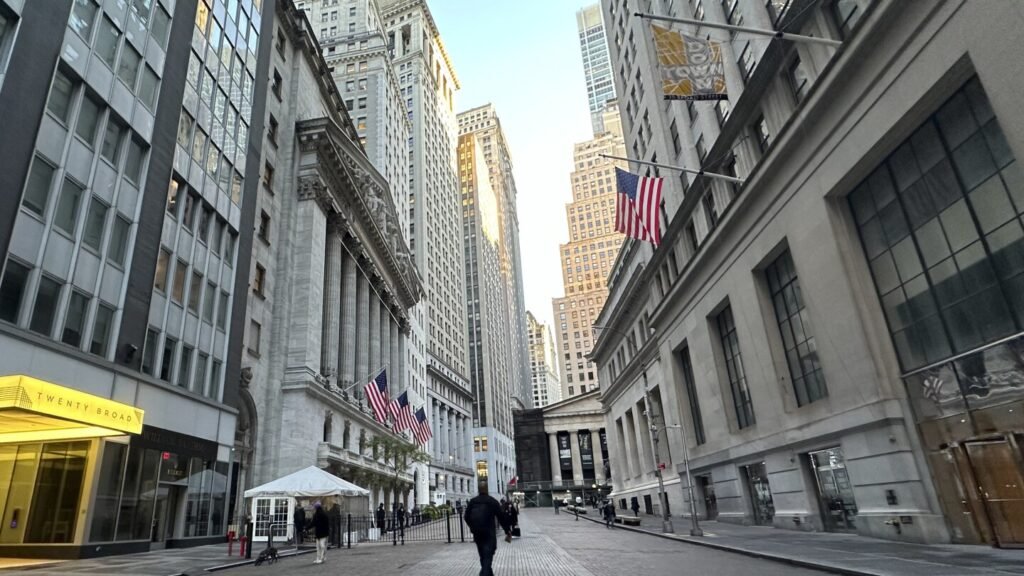NEW YORK (AP) — U.S. stocks are drifting around their records Thursday following the latest signals that the U.S. economy continues to hum.
The S&P 500 was 0.3% higher in afternoon trading and flirting with its record set early this week. The Dow Jones Industrial Average added 183 points, or 0.4%, to its own all-time high set the day before, and the Nasdaq composite was 0.6% higher, as of 1:30 p.m. Eastern time.
Nvidia and other companies in the chip industry were helping to lead the way after global heavyweight Taiwan Semiconductor Manufacturing Co. reported bigger profit for the latest quarter than analysts expected. TSMC credited strong demand related to smartphones and artificial intelligence, and its stock that trades in the United States jumped 13.1%.
The 2.9% rise for Nvidia was the strongest force pushing upward on the S&P 500, and it was a sharp turnaround from earlier in the week when a warning from a major Dutch supplier to the chip industry, ASML, sent stocks sinking across the industry. Because Nvidia and other tech stocks have grown so big, their movements pack extra weight on the S&P 500 and other indexes.
Treasury yields were also rising in the bond market following the latest encouraging reports on the U.S. economy.
U.S. retailers made more in sales in September than in August, and underlying growth trends within the data were better than economists expected. The strength was “all the more impressive in the face of stretched household finances, particularly among lower-income shoppers, and pre-election jitters,” according to Gary Schlossberg, market strategist at Wells Fargo Investment Institute.
A separate report, meanwhile, said fewer U.S. workers applied for unemployment benefits last week, a signal that layoffs nationwide are relatively low and aren’t damaging the job market.
Such data bolster the hope that has sent U.S. stocks to records: The economy could make a perfect escape from the worst inflation in generations, one that doesn’t end with a recession that many investors worried was nearly inevitable. And with the Federal Reserve now cutting interest rates to help the economy keep humming, the expectation among optimists is that stocks can rise even further.
Critics, meanwhile, warn that stock prices look too expensive given how much faster they’ve climbed than profits for companies.
Lower interest rates can ease the brakes off the economy, boost prices for investments and make borrowing bills less costly for households and businesses. And rates are heading lower around the world, with only a couple exceptions.
The European Central Bank on Thursday cut its main interest rate by a quarter of a percentage point. That helped send stock indexes higher by 1.2% in France and 0.8% in Germany. They halted a run of losses that began the day in Asian stock markets, where Japan’s Nikkei 225 fell 0.7% and Hong Kong’s Hang Seng dropped 1%.
On Wall Street, insurer Travelers was another winner and rose 7.9% after reporting stronger profit and revenue for the latest quarter than analysts expected. Higher income made from its investments and elsewhere helped cover greater losses due to Hurricane Helene and severe wind and hail storms in multiple states.
Blackstone also helped push indexes higher after the investor in real estate, hedge funds and other alternative investments reported stronger profit than expected. It climbed 7.1% after CEO Stephen Schwarzman said it’s seeing broad-based acceleration across its businesses.
They helped offset a 11.6% drop for Elevance Health, which reported weaker profit for the latest quarter than expected. The Blue Cross-Blue Shield insurer also cut its forecast for profit for the full year, saying it was dealing with a “timing mismatch” between Medicaid rates and higher claims from customers.
CSX fell 5.9% after falling short of analysts’ profit expectations for the latest quarter. The railroad also expects only modest volume growth the rest of the year as the Southeast rebuilds after two major hurricanes.
In the bond market, the yield on the 10-year Treasury rose to 4.10% from 4.02%. The two-year yield, which moves more closely with expectations for action by the Fed, rose to 3.99% from 3.94%.
All the strong recent reports on the U.S. economy have forced traders to abandon bets that the Federal Reserve could cut its main interest rate by another half a percentage point in November. Instead, they’re largely betting the Fed will move forward with a traditional-sized cut of a quarter of a percentage point, according to data from CME Group.
That shift in expectations has helped push Treasury yields higher.
___
AP Business Writers Matt Ott and Elaine Kurtenbach contributed.

